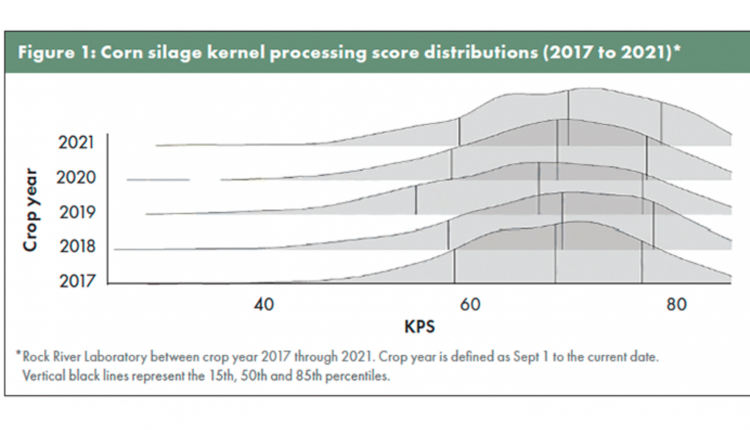The author is the director of nutrition research and innovation with Rock River Lab Inc, and adjunct assistant professor, University of Wisconsin-Madison’s Dairy Science Department.
Let us join together and wish the corn silage kernel processing score a belated happy 15th birthday!
Gonzalo Ferriera and Dave Mertens published the original article detailing how kernel processing score (KPS) related to in vitro rumen corn silage digestibility in December 2005. Commercial laboratories adopted this assay over the following five years, and it has now been around commercially for well over a decade.
For a quick refresher of the laboratory technique, the KPS equates to the percent of corn silage starch passing through a 4.75-millimeter (mm) sieve of a laboratory shaker. Think of this sieve as being like a sandbox strainer that many children entertain themselves with. Small sand particles pass through the strainer while larger particles or rocks do not.
The 4.75 mm gap is a similar width to a .22 caliber bullet, as we discussed in the February 2016 Hay and Forage Grower article titled “What’s the score?” Halved or whole kernels are captured on the 4.75 mm sieve, and obliterated kernels pass right through. Hence, 70% means that seven out of 10 kernels were processed well enough to pass right through a 4.75 mm gap.
Still a hot topic
As the KPS laboratory analysis matures, it continues to be one of the hottest topics with growers, dairy and beef producers, custom harvesters, and nutritionists. For example, during a recent invited talk in Manitowoc County, Wis., we were discussing corn silage quality and management, but the seminar took a sideways turn. While discussing the fact that this past year’s silage had harder grain and lower starch digestibility, we segued into a conversation about KPS.
A custom harvester commented that he’s noticed his self-propelled harvester processes whole-plant corn differently when chopping different hybrids. He stated the observation was fairly evident, then asked if we knew how KPS interacted with hybrid types. We discussed hard and soft kernel characteristics, but in response to his question, I passed along that we don’t have much, if any, research in this area. Setting the specific question aside, the room lit up with discussion around the topic. It was clear evidence to me that KPS remains relevant, and there’s much yet to learn.
From an end-user perspective, we’ve embraced the notion that corn silage kernels should be extremely well processed to optimize dairy and beef performance. More obliterated kernels logically would correlate to better grain digestion and use in cattle. Various field surveys have documented negative correlations between dairy fecal starch content and corn silage kernel processing score. This could be meaningful because we know that fecal starch content is directly tied to total tract starch digestibility.
While correlation between KPS and fecal starch or total tract starch digestibility does not prove causation, logic suggests the field survey results are meaningful. This year, KPS at harvest seems to be more important than ever, recognizing that the 2021 growing season generally yielded a corn crop with harder grain. In fact, dairy fecal starch measures have reflected this, so many are wondering what to do differently in the future, and KPS keeps coming up.
More to learn
In the absence of research, we don’t have a solid grasp of how a 10-unit bump in KPS may relate to dairy or beef production. Better understanding this relationship would be beneficial for economic projections, knowing we can always improve KPS by increasing roll differential and closing roll gaps to 1 mm or less. However, there are horsepower, diesel, and cost considerations when we push the extremes. Peer reviewed and published research would help us balance cost versus impact.
In 2022, we’re still left with a general understanding that a higher KPS is better for dairy or beef performance. Our industry appears to have reached a plateau in year over year KPS results as shown in Figure 1.

From 2010 to 2017, it was clear that the industry improved KPS as the population distributions shifted higher and higher. Then, in 2017, the distribution of KPS results settled in from year to year. Now it appears we’ve plateaued around 70% KPS, with the upper 15th percentile being just under 80%.
For the time being, and in the absence of research, this upper 15th percentile should be our KPS goal for optimal dairy or beef performance. In the future, I hope to be part of discussions that help balance the cost versus benefit.
We also need to recognize that KPS has a different meaning to dairy or beef farm economics at $5 to $6 per bushel corn prices relative to $2 to $3 per bushel price points of years past. With today’s thin margins and expensive grain prices, we need to capture every bit of value per kernel that is possible.
This article appeared in the February 2022 issue of Hay & Forage Grower on page 32.
Not a subscriber? Click to get the print magazine.

